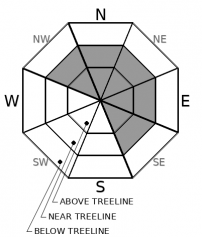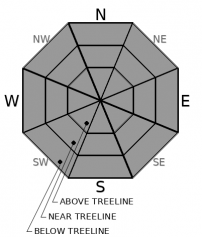| Saturday | Saturday Night | Sunday | |
|---|---|---|---|
| Weather: | Mostly cloudy skies becoming partly cloudy. Slight chance of rain in the morning. Snow levels 9000 feet. Chance of precipitation is 20%. | Partly cloudy. Slight chance of rain and snow after midnight. Snow levels 7500 feet decreasing to below 7000 feet after midnight. Chance of precipitation is 10%. | Cloudy. Chance of rain and snow through the morning. Snow in the afternoon. Snow levels 7000 feet. Chance of precipitation is 95%. |
| Temperatures: | 39 to 44. deg. F. | 27 to 32. deg. F. | 36 to 41. deg. F. |
| Mid Slope Winds: | Southwest 10 to 15 mph with gusts to 35 mph. | Southwest 10 to 15 mph. Gusts up to 35 mph increasing to 45 mph after midnight. | Southwest 20 to 30 mph increasing to 25 to 40 mph in the afternoon. Gusts up to 80 mph. |
| Expected snowfall: | No accumulation. | SWE = less than 0.10 inch. | No accumulation. 90% probability no accumulation. | SWE = none. | 70% probability of 2 to 6 inches. 30% probability of 6 to 10 inches. | SWE = up to 0.70 inch. |
| Saturday | Saturday Night | Sunday | |
|---|---|---|---|
| Weather: | Mostly cloudy then becoming partly cloudy. Slight chance of rain and snow in the morning. Snow levels 9000 feet. Chance of precipitation is 20%. | Partly cloudy. Snow levels 7500 feet decreasing to below 7000 feet after midnight. Chance of precipitation is 10%. | Mostly cloudy. Snow likely. Snow levels 7000 feet. Chance of precipitation is 95%. |
| Temperatures: | 36 to 42. deg. F. | 25 to 30. deg. F. | 31 to 36. deg. F. |
| Ridge Top Winds: | Southwest 15 to 30 mph. Gusts up to 55 mph decreasing to 45 mph in the afternoon. | Southwest 20 to 35 mph. Gusts up to 50 mph increasing to 70 mph after midnight. | Southwest 35 to 55 mph with gusts to 90 mph. |
| Expected snowfall: | Up to 1 inch. | SWE = trace amounts. | No accumulation. 90% probability no accumulation. | SWE = none. | 70% probability of 4 to 8 inches. 30% probability of 8 to 12 inches. | SWE = up to 0.70 inch. |




























